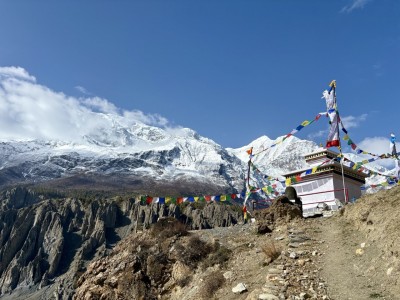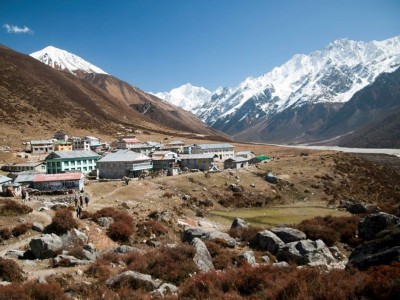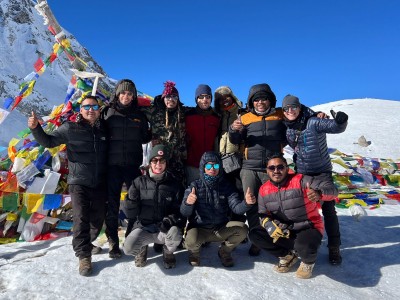Langtang trek is a beautiful trekking destination in Nepal. The Langtang region is full of biodiversity and culture. Some of the major highlights of Langtang trek 10 days includes the captivating snow clad Himalayas, distinctive landscapes, evergreen forests, incredible Langtang valley, and the Langtang national park. The area covered by the Langtang trek is the area of Langtang National Park area.
This national park is a home of wide varieties of plants and animal species. During this trek, you will see a wide variety in climatic zones beginning from sub-tropical to temperate to the alpine zone. Along with the tropical variations, you will also see diverse flora and faunas. The Red Panda, Himalayan bear, Himalayan Tahr, Snow Leopard, Goral etc. are found in abundance in the park.
The local ethnic communities in the Langtang region are Tamang, Bhotia, and Yolmo people. Being close to Tibet, life in the Langtang region has huge influences of the Tibetan lifestyle.
Trekking in Langtang region is possible throughout the year. Trekking in different seasons, you will be served with different delights. However, based on the weather conditions, and some other factors, Autumn and Spring are the best time for this trek.
Autumn and Spring have easy weather meaning that weather remains stable mostly in these seasons. Due to good weather and mild temperature, you will have an easy time trekking.
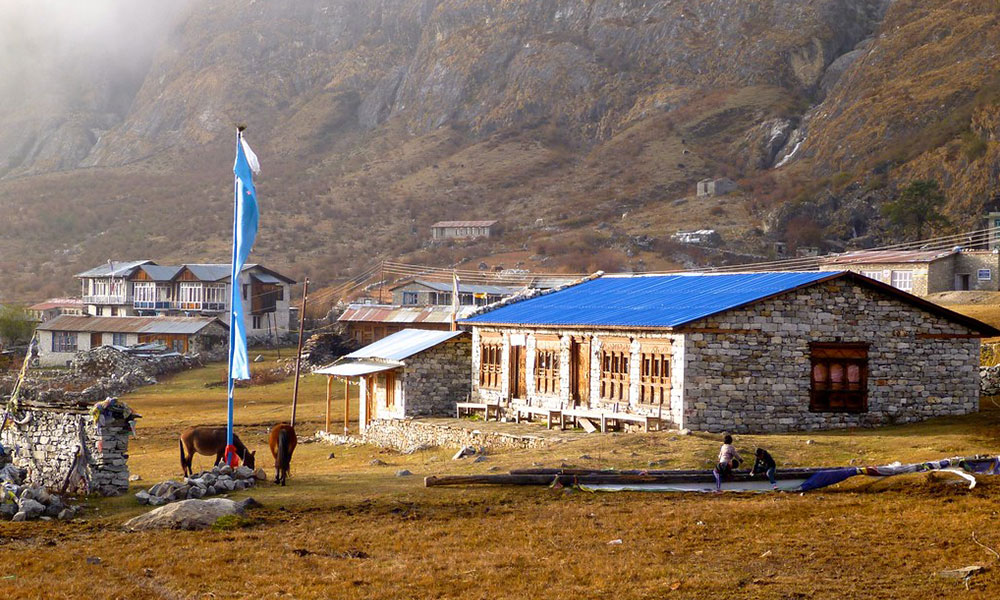
Trekking in Langtang in Peak Seasons
Autumn (September, October, and November) and Spring (March, April, and May) are the peak seasons to trek in the Langtang region. The peak times are the times when the Langtang region receives the maximum number of visitors. This time is popular amongst the internal as well as the international tourists.
Langtang Trek in Autumn
Autumn is the best season to trek in the Langtang region of Nepal. This season is popular due to its stable weather conditions and pleasing temperatures. The stable weather enhances the splendid surrounding vistas. You will see the clearest views of the Himalayas, exotic landscapes, lush jungles, and the amazing sceneries.
Days are warm and clear with stable weather. The blue and clear sky complements the stunning views of the mountains. Moreover, visibility will be great. The average temperature during the days varies between 10°C to 15°C. The higher altitudes are always colder than the lower ones. Mornings and the nights are a bit colder than the days. But with little warm gears, you will have a pleasing time.
Since autumn is the peak season, you will see lots of fellow trekkers on the trek route. Also, you might have difficulty in finding places for stays if you do not book the teahouses earlier. If you are trekking with a guide/porter, they will help you arrange for your stays.
If you are trekking in Langtang during early September, prepare to encounter very few occasional rains. This time, though is officially autumn, still experiences the post-monsoon weather.
Tips for Trekking in Langtang in Autumn
- Book the teahouses earlier.
- Start early. It is always good to get to your next destination before evening.
- Carry appropriate clothing and trekking gears
- Drink plenty of water. Clean pure drinking water.
- Hire a porter. S/he will help share your loads.
- Follow the standard trekking trails, avoid the shortcuts.
Langtang Trek in Spring
Spring is the season of colours and joys. Nature is at its best during Spring. You will see an abundance of Rhododendron blossoms while trekking in Langtang in Spring. You will also see small colourful wildflowers on the wide meadows.
Spring is a beautiful time to trek. It is the best trekking season for nature lovers. The blue skies, astounding Himalayas, tranquil Langtang valley, and mild temperature while trekking, Spring is indeed a beat time for Langtang trekking.
Early March is still cold with chilly nights and mornings at higher elevations. While the average daytime temperature in the Langtang region in Spring happens between 10°C to 20°C. Walking under the warm sun while soft mountain breezes kiss your skin is a wonderful experience.
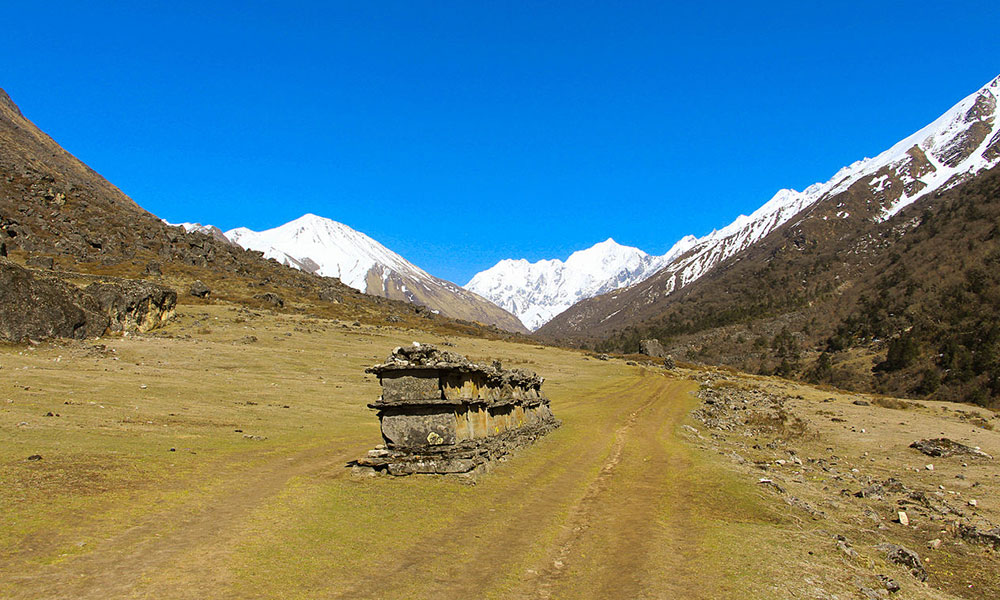
Tips for trekking in Langtang in Spring
- Book your teahouses earlier
- Do sufficient packing
- Take care of your health
- Do not smell the wildflowers as some might be poisonous
Trekking in Langtang in Offseasons
Summer (June, July, and August) and Winter (December, January, and February) are the off seasons for trekking in the Langtang region. By offseasons, i am not meaning to say that Langtang trek is not possible during these times. Trekking in Langtang in offseasons is absolutely possible but due to extreme weather conditions, trekking can be harder.
The weather and temperature in offseasons are quite extreme and are frequently varying. Winter is extremely cold and with monsoon, the region becomes very wet. With good plans and preparations, anything is achievable. But remember you should make yourself ready to face the worse and harsh weather conditions.
Langtang trek in Summer/Monsoon
Summer is the hottest time of the year in the Langtang region. In the region, summer and monsoon coincide. Thus, summer season also receives the maximum rainfall. Trekking to Langtang during the hottest and the wettest months is quite uncommon among the trekkers. But if this is the only free time that you have, you should definitely do this trek without any abeyance.
In Summer, the lower regions in Langtang experience a range of temperature varying between 25 to 30°C. Days are sunny, bright, and hot of course. But the temperature decreases as you trek towards the higher altitudes. The temperature at the higher elevations drops down to around 10°C in the month of July.
Summer is not only sunny but is rainy as well. Mostly, it starts raining during the afternoons. The rain starting in the evenings continues over the night till early morning, the next day. Due to almost everyday rainfall, the trekking trails becomes wet, muddy, and slippery. Also, the grasses near the trails grow big, and the forests become denser and greener.
You will have to fight with many summer bugs like mosquitoes, earthworms, and leeches on the trek. Also, due to heavy moisture in the air, your vision will get blurry sometimes. Sometimes, dense fog might cover the beautiful sceneries around.
Everything has its brighter side. Summer treks to Langtang are the best opportunities for the curious botanists. Monsoon is the reproduction time of the vegetations. They grow very dense and beautiful in monsoon, hence making the studies and researches of a botanist easier.
Also, the empty trail is another perk to those who prefer peace and quiet trails. Also, since this is the time when the teahouses get very fewer visitors, they will offer you certain discounts and will also provide you with their best services. For nature lovers, they will see the striking views of the rainwashed mountainscapes.
.jpg)
Tips for Trekking in Langtang in Summer/Monsoon
- Get a good quality raincoat
- Get a perfect rain cover for your backpack
- Wear rainproof trekking boots with sturdy soles and high ankle support
- Use insect repellant creams
- Carry some table salts. It will help against leech bites.
- Arrange properly all the necessary trekking gears.
Langtang Trek in Winter
Winter is the coldest time of the year in the Langtang region. In winter, the higher elevations will be very cold with frequent snowfalls in mornings and in the nights. The nights will be very cold with temperatures dropping below the freezing temperatures.
The temperature during the days ranges between 6°C to 9°C on average. You should wear warm clothing to prevent you from catching a cold. Wear warm hats, down jackets, and trekking pants with fleece. Also, wear thermals as the inner layer. Also, days become shorter in winter. The sunrays aren’t as warm as in the other seasons. For nights, you must carry extra warm gears and sleeping bags. The teahouses do not provide extra heating in the dining halls but not in the rooms. Thus, the rooms will be very cold.
The entire Langtang valley hibernates under the thick blanket of white snow. The views of white mountains touching the blue skies are beyond the world. People in the region stay within their houses keeping themselves warm. You will see the beautiful snowy world with the fascinating Himalayas creating a fairytale picture.
Trekking to Langtang in winter may not be as easy as you think. The weather in the region becomes highly unstable. You might have to encounter a series of snowfalls followed by harsh winds. Sometimes, the clumsy weather pertains the region for a number of days. If that happens, you have to halt your trek and extend it for some more days.
The perks of trekking in winter are the less crowded trails. Also, for keen photographers, this is a perfect time for the best winter photographies. Also, you will get the best services and heavy discounts offered at the teahouses while trekking in this season.
Tips for Trekking in Langtang in Winter
- Adequate warm gear is the must to sustain the cold. Carefully make the packing lists and buy everything that you will need.
- Get a good quality sleeping bag since the nights are going to be so cold.
- Wear gaiters to prevent the lumps of snow going inside your shoes and wetting your socks.
- Be extra careful walking over the snow.
- Keep updated about the local weather in the region. DO not go out during harsh weathers.
At Last,
Langtang is a beautiful trekking region where you can trek in any time of the year. Though Autumn and Spring are the peak seasons to trek, you can go trekking in Langtang in any seasons. Trekking in different time will give you different experiences. Plan your trek perfectly and pack wisely, and you will have a wonderful trek.
For any queries or suggestions, feel free to contact us.

